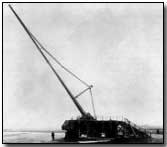Primary Documents - William G Sharp on the Paris Gun, 3 April 1918
 Reproduced below is an
account of the early use of the German Kaiser Wilhelm Geschutz - better
known as the
Paris Gun, in March 1918.
Reproduced below is an
account of the early use of the German Kaiser Wilhelm Geschutz - better
known as the
Paris Gun, in March 1918.
Written by the U.S. Ambassador to Paris, William G Sharp, his account records how a shell from the enormous gun - capable of firing shells into the stratosphere from locations as far as 131km from Paris - crashed through the roof of the church at St. Gervais during a service on Good Friday, 29 March 1918, killing approximately 100 people.
The Paris Gun was more of a propaganda weapon used by the Germans at home, and inflicted relatively little actual damage to Paris; it's terror capability was initially much feared however. It was first fired on 21 March 1918 to coincide with the opening of the great German Spring Offensive.
Click here to read a British press report on the gun.
William G Sharp on the Paris Gun
Washington, April 3rd
The Secretary of State has received from Ambassador Sharp in Paris a graphic report of his visit to the scene of the horrible tragedy which occurred on the afternoon of Good Friday in a church by the explosion of a German shell projected from far back of the enemy lines a distance of more than seventy miles.
The appalling destruction wrought by this shell is, as the Ambassador remarked, probably not equalled by any single discharge of any hostile gun in the cruelty and horrors of its results.
In no other one spot in Paris, even where poverty had gathered on that holy day to worship, could destruction of life have been so great. Nearly a hundred mangled corpses lying in the morgues, with almost as many seriously wounded, attested to the measure of the toll exacted.
Far up to the high, vaulted arches, between the flying buttresses well to the front of the church, is a great gap in the wall, from which fell upon the heads of the devoted worshipers many tons of solid masonry. It was this that caused such a great loss of life.
As the Ambassador entered the church, where but a few hours before had been gathered the worshipers, he could easily picture the scene that followed the explosion. The amount of debris, remaining just as it fell on the floor, covered the entire space between the lofty columns supporting the arches at each side.
Only a miracle could have saved from death or serious injury those who escaped the falling mass. The scene was that of some horrible shambles, and it was not until well into the night that all the bodies were recovered. Upon the floor in many places could still he seen the blood of the victims among whom were many prominent and well-to-do people.
The Minister was deeply affected as he spoke of the great loss through the Secretary's [NB: Secretary of the Swiss Legation] death. The Secretary was well known in Washington, where he served with the Swiss Legation from 1902 to 1904, and was very highly esteemed by all who knew him.
In conclusion, Mr. Sharp says that the exceptional circumstances under which this tragedy occurred, both as to the sacred character of the day and the place, have greatly aroused the indignation, of the people of Paris toward an enemy who seeks to destroy human life without regard to the immunities prescribed by the laws of civilization and humanity, and, instead of terrorizing the people, shells of the great cannons, as well as the bombs dropped from the German airplanes, only serve to strengthen the resolve of the French to resist, to the last man if necessary, the invasion of such a foe.
Source: Source Records of the Great War, Vol. VI, ed. Charles F. Horne, National Alumni 1923
A 'scorched earth policy' was the practice of deliberately destroying crops, food supplies and other facilities to prevent an invading enemy from using them.
- Did you know?
